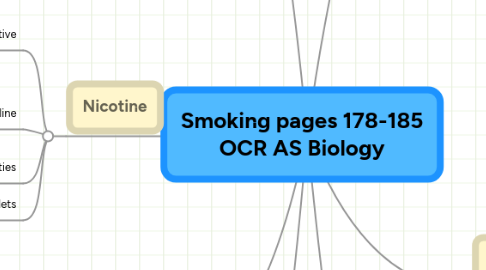
1. Tar
1.1. short term
1.1.1. settles on lining of airways and alveolus
1.1.1.1. increases diffusion distance for O2 and CO2
1.1.1.2. allergic reaction
1.1.1.2.1. smooth muscle contracts
1.1.2. paralyses cilia
1.1.2.1. can't move layer of mucus up and away to mouth
1.1.3. goblet cells stimulated
1.1.3.1. more mucus secreted
1.1.3.1.1. bacteria and viruses reproduce in mucus
1.2. long term
1.2.1. bacteria laden mucus in lungs
1.2.1.1. attempt to shift
1.2.1.1.1. Smockers cough
1.2.1.2. irritates
1.2.1.3. infections inflame lining of airways
1.2.1.3.1. layer of epithelium
1.2.1.3.2. attracts white blood cells
2. Nicotine
2.1. addictive
2.1.1. body doesn't feel well without it
2.1.2. mimics action of transmitter substances at synapses between nerves
2.1.2.1. nervous system more sensitive, smoker more alert
2.2. releases adrenaline
2.2.1. increases breathing and heart rate
2.2.1.1. increases blood pressure
2.2.2. constriction of arterioles
2.3. constriction of arterioles in extremities
2.3.1. reduces blood flow and O2 delivery
2.3.1.1. need for amputation
2.4. platelets
2.4.1. sticky
2.4.1.1. increases risk of blood clot or thrombus
3. Carbon Monoxide
3.1. combines with haemoglobin in RBC
3.1.1. =carboxyhaemoglobin
3.1.1.1. reduces O2 carrying capacity
3.1.1.1.1. smokers feel when excercising
3.2. damage lining of the arteries
3.2.1. with high blood pressure
3.2.1.1. damage!
3.2.1.1.1. white blood cells
4. Cardiovascular diseases
4.1. disease of the heart caused by malfunction of the coronary arteries
4.2. atheroma
4.2.1. narrows lumen
4.2.1.1. friction between blood and artery walls
4.2.1.1.1. heart pumps against it
4.2.2. artery walls more elastic
4.2.2.1. artery walls can't dilate or recoil easily
4.2.3. atherosclerosis
4.2.3.1. hardening of artery walls
4.2.3.1.1. deposition of minerals e.g. calcium
4.2.4. under the endothelium
4.2.4.1. grow enough- break through inner lining of artery
4.2.5. form a plaque
4.2.5.1. sticks into the lumen
4.2.5.1.1. if membrane broken RBC will stick to it
4.2.5.2. blood can't flow smoothly
4.2.5.2.1. may clot
4.3. coronary artery prone
4.3.1. lumen narrowed by clots
4.3.1.1. reduces blood flow to heart muscle
4.3.1.1.1. less O2 for Respiration
5. carcinogens
5.1. Benzopyrene
5.2. enter lung tissue cells and nucleus.
5.2.1. affect genetic material
5.2.1.1. =mutation
5.2.1.2. uncontrolled cell division
5.2.1.2.1. cancer
6. diseases
6.1. chronic bronchitus
6.1.1. inflammation of lining airways
6.1.2. damage to cilia and overproduction of mucus
6.1.2.1. mucus collects in lungs
6.1.3. symptoms
6.1.3.1. irritation to the lungs
6.1.3.2. coughing
6.1.3.3. coughing up mucus
6.1.3.3.1. filled with bacteria and white blood cells
6.1.3.4. increase in lung infection
6.2. Emphysema
6.2.1. loss of elasticity to alveoli
6.2.1.1. alveoli can burst
6.2.1.2. harder to exhale
6.2.2. lungs have reduced SA for gas exchange
6.2.3. symptoms
6.2.3.1. short of breath
6.2.3.1.1. excercise
6.2.3.2. breathing shallow, more rapid
6.2.3.3. blood less well oxygenated
6.2.3.3.1. fatigue occurs
6.3. chronic obstructive pulmonary disease
6.3.1. chronic bronchitis
6.3.2. emphysema
6.3.3. asthma
6.4. lung cancer
6.4.1. symptoms
6.4.1.1. coughing
6.4.1.2. shortness of breath
6.4.1.3. pain in chest
6.4.1.4. blood coughed up in the sputum
6.4.1.4.1. alerts to lung cancer
7. Epidemiology
7.1. WHO
7.1.1. identify links between
7.1.1.1. countries at greater risk
7.1.1.2. age range
7.1.1.2.1. young ppl are smoking more
7.1.1.3. sex
7.1.1.4. lifestyle factors
7.1.2. help countries/ organisations target further spending
7.1.3. target research to find cure or cause
7.1.4. screening procedures, find those at risk early
7.1.5. advice and education for population most at risk
7.1.6. future risk places
7.1.7. use preventative measures ( vaccinations)
7.1.8. campaigns and preventative measures
7.2. distribution of a disease in populations, and factors that influence its spread
7.2.1. increased smoking= increased deaths
7.2.2. regular smoker x3 more likely to die prematurely than non smoker
7.2.3. 50% smokers die of related diseases
7.2.4. more cigarettes per day, more likely to die
7.3. lung cancer
7.3.1. 18 times more likely
7.3.2. 25% die
7.3.3. chances of death reduce immediately
7.4. chronic obstructive pulmonary disease
7.4.1. rare in non smokers
7.4.2. 20% have emphysema
7.4.3. 90% of ppl with emphysema are smokers
7.5. cardiovascular diseases
7.5.1. not easy
7.5.1.1. so many other risk factors
7.6. Animals
7.6.1. filtered
7.6.1.1. healthier
7.6.1.1.1. some cancer
7.6.1.2. tar collected in filter
7.6.1.2.1. contains carcinogens
7.6.2. non- filtered
7.6.2.1. lung cancer and chronic obstructive pulmonary diseases

